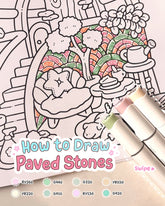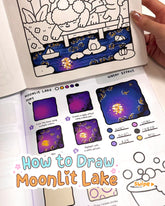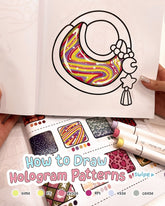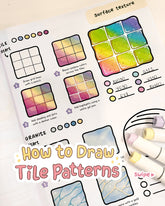Easy Coloring Tips for Beginners
Table of Contents
Struggling to make your coloring pages look like the ones you see online? Messy blends, uneven shading, colors bleeding through? Or maybe you’re just not sure where to start?
That’s why we’ve rounded up a few easy coloring tips to help you fix common mistakes and make your pages look smoother, brighter and way more satisfying.
Color Swatch Sheet

The color on your marker cap almost never matches what shows up on paper. As you can see, colors usually look a bit darker once they dry, so it’s always good to test them out first.
Beginner tips:
- Grab a blank sheet of your marker paper and color a small box for every marker you own. Write the number next to it.
- Always swatch on the same type of paper you’ll be coloring on for the most reliable results.
Preventing Bleed-through

Ever had your marker ink bleed through and mess up the next page?
Just place one paper sheet and one plastic sheet underneath the page you’re working on. It’s an easy, no-bleed combo that keeps your artwork safe perfect for beginners!
Color Inside The Line

That sneaky ink spreads fast! Alcohol markers love to travel a little beyond where you start.
To get sharp, clean edges, don't color right up to the black line. Stop about 1-2mm inside the line. The ink will 'crawl' or 'feather' the rest of the way to the line by itself.
Beginner tip: Color larger areas first and save the tiny details for last.
How To Avoid Streaks With Alcohol Markers?

Streaks happen when the ink dries before you finish an area, that’s what leaves those uneven lines. One of the simplest marker coloring tips is to keep the surface slightly wet with ink while you move, so your color blends stay smooth and even. Here are tips:
- Work in small, manageable sections (like one leaf or one part of a shirt).
- Color using small, overlapping circles, which keeps the ink edge wet.
- Saturate the small area completely before moving to the next small area.
How To Shade With Alcohol Markers?

Shading adds a bit of depth by using darker tones where shadows naturally fall. Stick with two or three markers in the same color family for a smooth look. Here’s how to do it:
- Take two or three markers in the same color family (light, medium and dark version of a hue).
- First, color the area with your lightest shade.
- Then, take the darkest shade and lightly flick or add it to the spots that should be in shadow (for example, along the edges or under a shape).
How To Blend With Alcohol Markers?

What are "Neighbor Shades"?
These are colors that are in the same family and are close in number. Think: a light green, a medium green, and a dark green.
The Easiest First Blend (Light-to-Dark)
- Color your entire small shape with your lightest color.
- While that ink is still wet, add your medium color where you want the shadow to start.
- Go back with your blender marker and scrub over the "seam" where the two colors meet. The alcohol in the blender will reactivate the medium ink and "blur" the line, creating a beautiful, smooth blend.
How To Use Acrylics?

- Let each layer dry completely before adding another color.
- Use light pressure to avoid thick, clumpy strokes.
- Always wait until it’s fully dry before closing your book.
FAQs
1. Can I start coloring even if I don’t have many markers?
Absolutely! A small set is enough to learn blending, layering, and control. Once you know how colors behave, even five shades can create something beautiful.
2. Why do my alcohol markers leave streaks?
That happens when the ink dries before you finish an area. Try coloring smaller sections in smooth circles and keep the surface slightly wet so colors blend evenly.
3. My colors keep bleeding outside the lines. What can I do?
Don’t color right up to the edge. Leave a tiny gap and let the ink spread naturally. It’ll “crawl” to the line and keep your edges clean.
4. How do I make my coloring look less flat?
Use two or three tones from the same color family. Start light, then softly add darker shades where shadows would fall. It gives your page more shape and depth.
5. Why do colors look darker on paper than on the marker cap?
Marker caps can be misleading. Always swatch first on the same paper you’ll use. The color usually dries one or two tones deeper.
6. What Is a Colorless Blender Marker?
A colorless blender marker contains no pigment. It’s used to lighten colors, add highlights, fix small mistakes, or create textures, not to blend two colors. Think of it as a tool to push or fade ink, not mix it.
7. What if my marker bleeds through the page and ruins the next one?
That happens more than you'd think. Use heavier paper or put a protector sheet underneath, and test a marker on the corner before you colour the main area.
8. Can I mix markers, pencils and acrylics on the same page?
Yes, but test first. Use markers for base color, pencils for shading, and acrylics for highlights once everything’s dry. It adds texture without damaging your page.
9. How to Store Markers So They Don’t Dry Out Quickly?
Store markers flat (horizontal) to keep the ink evenly distributed, especially dual-tip ones. Always cap them tightly, avoid heat and sunlight, and use airtight boxes if storing long-term. This helps prevent drying and keeps the ink flow balanced for both tips.











